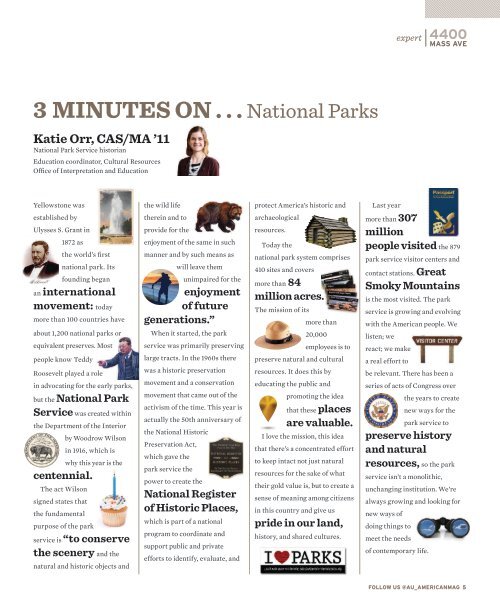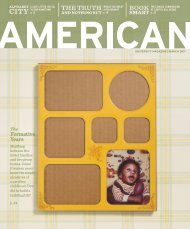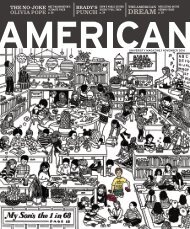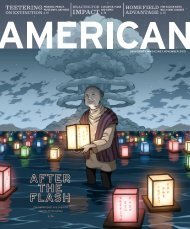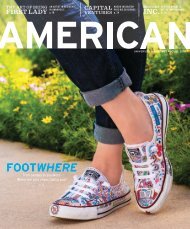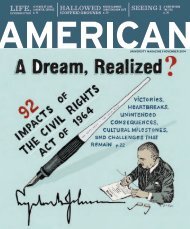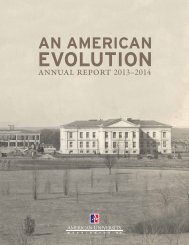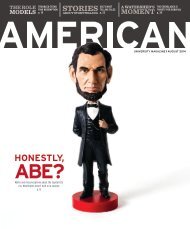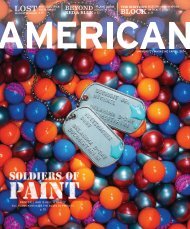American magazine, July 2016
In this issue explore DC street art, run away with the Street Light Circus, meet AU’s Olympic hopefuls, reminisce about commencements past, hop on the Metro to the Smithsonian, and get to know some of AU’s 1,875 Boston transplants. Also in the July issue: 3 minutes on the national parks, 88 years of yearbooks, and a beer quiz.
In this issue explore DC street art, run away with the Street Light Circus, meet AU’s Olympic hopefuls, reminisce about commencements past, hop on the Metro to the Smithsonian, and get to know some of AU’s 1,875 Boston transplants. Also in the July issue: 3 minutes on the national parks, 88 years of yearbooks, and a beer quiz.
Create successful ePaper yourself
Turn your PDF publications into a flip-book with our unique Google optimized e-Paper software.
expert<br />
3 MINUTES ON . . . National Parks<br />
Katie Orr, CAS/MA ’11<br />
National Park Service historian<br />
Education coordinator, Cultural Resources<br />
Office of Interpretation and Education<br />
Yellowstone was<br />
established by<br />
Ulysses S. Grant in<br />
1872 as<br />
the world’s first<br />
national park. Its<br />
founding began<br />
an international<br />
movement: today<br />
more than 100 countries have<br />
about 1,200 national parks or<br />
equivalent preserves. Most<br />
people know Teddy<br />
Roosevelt played a role<br />
in advocating for the early parks,<br />
but the National Park<br />
Service was created within<br />
the Department of the Interior<br />
by Woodrow Wilson<br />
in 1916, which is<br />
why this year is the<br />
centennial.<br />
The act Wilson<br />
signed states that<br />
the fundamental<br />
purpose of the park<br />
service is “to conserve<br />
the scenery and the<br />
natural and historic objects and<br />
the wild life<br />
therein and to<br />
provide for the<br />
enjoyment of the same in such<br />
manner and by such means as<br />
will leave them<br />
unimpaired for the<br />
enjoyment<br />
of future<br />
generations.”<br />
When it started, the park<br />
service was primarily preserving<br />
large tracts. In the 1960s there<br />
was a historic preservation<br />
movement and a conservation<br />
movement that came out of the<br />
activism of the time. This year is<br />
actually the 50th anniversary of<br />
the National Historic<br />
Preservation Act,<br />
which gave the<br />
park service the<br />
power to create the<br />
National Register<br />
of Historic Places,<br />
which is part of a national<br />
program to coordinate and<br />
support public and private<br />
efforts to identify, evaluate, and<br />
protect America’s historic and<br />
archaeological<br />
resources.<br />
Today the<br />
national park system comprises<br />
410 sites and covers<br />
more than 84<br />
million acres.<br />
The mission of its<br />
more than<br />
20,000<br />
employees is to<br />
preserve natural and cultural<br />
resources. It does this by<br />
educating the public and<br />
promoting the idea<br />
that these places<br />
are valuable.<br />
I love the mission, this idea<br />
that there’s a concentrated effort<br />
to keep intact not just natural<br />
resources for the sake of what<br />
their gold value is, but to create a<br />
sense of meaning among citizens<br />
in this country and give us<br />
pride in our land,<br />
history, and shared cultures.<br />
Last year<br />
more than 307<br />
million<br />
people visited the 879<br />
park service visitor centers and<br />
contact stations. Great<br />
Smoky Mountains<br />
is the most visited. The park<br />
service is growing and evolving<br />
with the <strong>American</strong> people. We<br />
listen; we<br />
react; we make<br />
a real effort to<br />
be relevant. There has been a<br />
series of acts of Congress over<br />
the years to create<br />
new ways for the<br />
park service to<br />
preserve history<br />
and natural<br />
resources, so the park<br />
service isn’t a monolithic,<br />
unchanging institution. We’re<br />
always growing and looking for<br />
new ways of<br />
doing things to<br />
meet the needs<br />
of contemporary life.<br />
FOLLOW US @AU_AMERICANMAG 5


